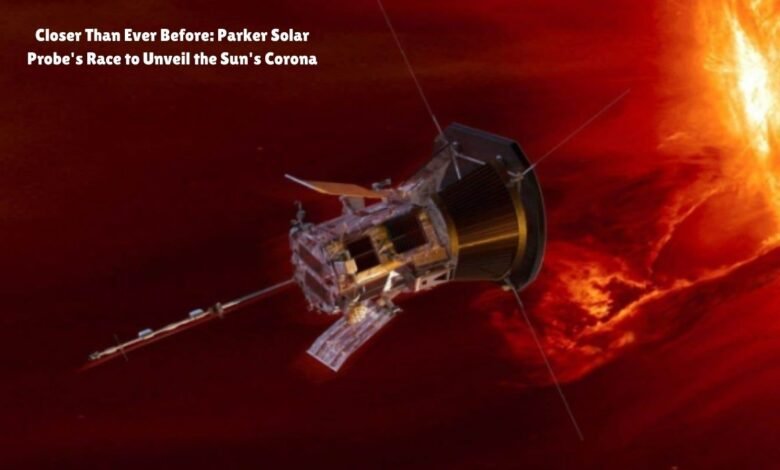Chasing the Sun: Parker Solar Probe Races to Unlock Solar Secrets

The energy that keeps life going across the solar system is provided by our star, Sun. But a lot of its mysteries hide in the corona, its hot atmosphere. The goal of NASA’s Parker Solar Probe is to reveal these mysteries. It is approaching the Sun faster than any previous spacecraft, making it the fastest thing ever created by humans.
This cutting-edge mission seeks to learn more about the corona, shedding light on the Sun’s processes and effects on Earth. Come along as we look at the fascinating mission of the Parker Solar Probe & its mission to unravel the mysteries surrounding our nearest star.
Goals of the Mission
Three primary objectives motivate Parker Solar Probe:
Tracing Energy Flow: To gain a better understanding of Sun’s activity, discover how energy heats and accelerates solar wind and corona.
Dynamics of Plasma and Magnetic Fields: Find out how solar wind forms & accelerates by studying structure & dynamics of plasma & magnetic fields where it first appears.
Energetic Particle Exploration: To understand space weather events and their effects on Earth, study acceleration and transportation of high-energy particles.
Data and Timeline
Parker Solar Probe is on an adventurous mission to study the Sun, using a unique path to achieve its goals. Here are some milestones and data points:
16th Flyby: Parker Solar Probe recently completed its 16th flyby of Sun, coming within 53 million miles of it. This close approach allowed spacecraft to collect valuable data about Sun’s atmosphere, solar winds and magnetic fields.
Speed & Health: The Parker Solar Probe recently attained a remarkable speed of 586,782 kilometers per hour, or almost 365,000 miles per hour. The spacecraft needs to travel at this amazing speed in order to reach near enough to the Sun to collect useful data.
NASA has verified that spacecraft is safe and functioning as expected following this rapid solar pass. Probe’s ability to carry out its objective of studying Sun’s atmosphere, solar winds and magnetic fields is dependent on this successful pass.
Parker Solar Probe’s ability to travel at such high speeds and at such close proximity to Sun is evidence of its sophisticated engineering and technological breakthroughs. It also gives us comfort in knowing that spacecraft can endure hostile conditions in orbit & keep sending back crucial scientific data.
There’s more to this expedition than just speed and near misses with Sun. It concerns ground-breaking science that results from these audacious actions. Parker Solar Probe is still paving path for future discoveries concerning our nearest star & its effects on Earth by surviving and growing at such high speeds.
These milestones highlight the progress and success of the Parker Solar Probe in its mission to unlock the mysteries of the Sun.
Upcoming Venus Flyby
Parker Solar Probe will make its sixth flyby of Venus on August 21, 2023. Probe will use Venus’s gravity to alter its course and approach Sun even closer, making this an exciting development. Spacecraft will be in a better position to undertake observations in future & collect crucial information about our star by doing this.
It’s a brilliant approach to conserve fuel & modify spacecraft’s trajectory to use gravity aids from planets like Venus. With aid of this method, Parker Solar Probe is able to get closer to Sun with each visit, enabling it to conduct more in-depth research on the corona, Sun’s outer atmosphere.
Living With a Star Program
A component of NASA’s Living With Star project is Parker Solar Probe. Understanding link between Sun and Earth, particularly how solar activity impacts Earth, is main goal of this research. Solar flares and coronal mass ejections are examples of space weather occurrences that can affect power systems, satellite communications and even astronaut safety in orbit.
Through close-up observations of Sun, Parker Solar Probe contributes to scientific understanding of these space weather phenomena. Information gathered by probe will assist safeguard our technologically dependent society by enhancing our capacity to anticipate and prepare for solar storms.
Importance of Parker Solar Probe
The Parker Solar Probe is a groundbreaking mission designed to answer some of the most important questions about the Sun. It studies how energy moves through solar corona, dynamics of solar plasma and magnetic fields and how high-energy particles are accelerated and transported.
Each flyby, whether of Sun or Venus, brings probe closer to its goal of unlocking secrets of our star. Mission’s success depends on spacecraft’s precise navigation, reliable data collection & resilience to radiation and intense heat.
- How AI Is Changing NASA’s Mars Rover Science
- A BeiDou-like satnav system for the moon? Chinese scientists plot a possible route
- Icy Planetesimals: The Icy Secret to Earth’s Water
Mission Overview for Parker Solar Probe Makes a Daring Approach
A ground-breaking effort to discover more about Sun and its effects on Earth is NASA’s Parker Solar Probe. In order to further solar research, this spacecraft is investigating:
- Flow of energy that warms and speeds up the solar wind and corona.
- Plasma Dynamics: Composition & movement of magnetic & plasma fields where solar wind originates.
- Energetic Particles: Acceleration & transportation of high-energy particles.
This data is being gathered by Parker Solar Probe in attempt to answer significant Sun-related questions. Along way, we hope to make important discoveries that will pave way for future space travel. Additionally, by reducing impact of space weather on our technologically reliant society this mission helps.
Historic Parker Solar Probe project aims to reveal Sun’s mysteries & how it affects Earth.



